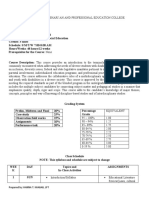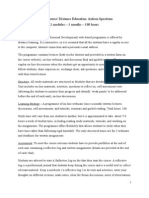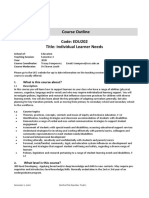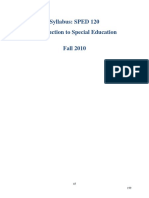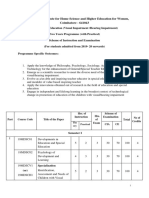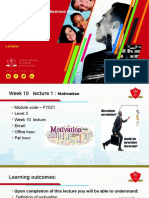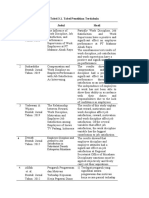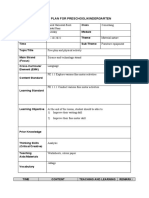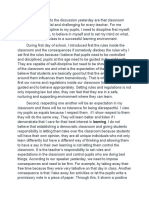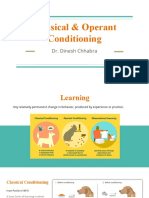Syllabus - ABA 105
Uploaded by
ScribdTranslationsSyllabus - ABA 105
Uploaded by
ScribdTranslationsSYNOPSIS
1 - INTRODUCTION AND INITIAL CONCEPTS
30h
Objective: To present the historical construction of the diagnosis of the Disorder.
Autistic Spectrum and the main explanatory theories.
2 - BASIC CONCEPTS OF BEHAVIOR ANALYSIS
APPLIED
100h
Objective: Understand and describe the learning processes in
perspective of Operant Behavior. Topics: Radical Behaviorism;
Experimental Analysis of Behavior; 3-term Contingency;
Learning through reinforcement consequences; Aversive control and its effects;
Stimulus control and the role of the environment; Reinforcement schedules;
Establishing and motivating operations; Equivalence of stimuli.
3 - INTRODUCTION TO VERBAL BEHAVIOR
70h
Objective: Describe and analyze verbal and linguistic processes from a perspective
from the analysis of behavior applied to people with ASD; Operant Definition
of verbal behavior; Verbal operants: mando, tact, intraverbal, echoic,
textual, copy and dictation; Functional Analysis of verbal episodes; Application of
verbal behavior in the context of teaching individuals with ASD; Teaching of
echoic, tact, mand, intraverbal and grammatical classes.
4 - SYMBOLIC BEHAVIOR AND LITERACY
15h
Objective: Understand the main concepts of class formations
equivalents of stimuli and the main literacy program studies
for people with ASD in Applied Behavior Analysis. Topics: A
formation of equivalent stimulus classes and their control variables; A
complexity and superselectivity of stimuli (restricted control); Effects
interactive training arrangements; Reading teaching for people with autism spectrum disorder; Teaching
of numerical relationships for people with ASD.
5 - EVALUATION INSTRUMENTS
Workload: 85h
Objective: To know the main general assessment instruments. Handle them.
possible instruments to be applied in different contexts. Topics:
Observing e recording o behavior; Portage Inventory
Operacionalizado; ABLA-R; VB-MAPP; ABLLS-R; Análise Funcional
observational; Experimental Functional Analysis.
6 - BEHAVIOR MANAGEMENT
15h
Objective: To present the different functions of inappropriate behaviors and
your management. Topics: Behaviors maintained by attention; Behaviors
maintained for escape/dodge; Behaviors of auto-stimulation;
Behaviors maintained by tangible reinforcements; Intervention strategies;
Types of differential reinforcement; Undesired effects of extinction and punishment.
7 -TEACHING STRATEGIES
Workload: 85h
Objective: Understand and learn to practice the main teaching strategies
for people with atypical development. Topics: Incidental teaching; Training
of Pivotal Responses; Denver Model of early intervention; Teaching by
Discrete Attempts; Behavioral Linking.
8 - DEVELOPMENT OF THE INDIVIDUALIZED TEACHING PLAN
BEHAVIORAL PROGRAMS
Workload: 50h
Objective: Discriminate the differences between the curricular levels. Develop a
Individualized Teaching Plan, taking into account the repertoire of
educating and the goals established in partnership with your family. Topics:
Conversion of evaluation to program selection; Defining objectives;
Training of applicators; Supervision.
9 - AUTISM IN ADULTHOOD
Workload: 50h
Objective: To present the specific processes of dealing with autism in
adolescence and adulthood and discuss possibilities in the field of intervention and
the technical solutions for public policy. AFLLS; Defining programs of
education (with functional emphasis); Sexuality; Aggressive behavior-
possibilities; Models of assisted living.
10 - ALTERNATIVE COMMUNICATION
Workload: 15h
Objective: Theoretical basis for Alternative Communication and some reflections on
communication. Topics: Adaptation of the resource format for CA; Types of
stimuli and strategies used and how to produce; Main systems of
communication; Interacting with the student who cannot communicate; What
what to do when a student is unable to write; Communication system
alternative and/or supplementary and its importance; Low and high resources
technology; Resources to work with students who have difficulties in
writing, but they are able to become literate; autism and motor comorbidities and their
assistance in alternative communication; Learning and AAC; Apraxia and autism
CA; Behavioral management for the proper use of CA.
11 - BEHAVIOR INTERVENTION STRATEGIES
IN GROUP
Workload: 35h
Objective: Understand the concepts related to social skills and their
development in the education of people with developmental delays in
educational context; Learning by modeling and imitation; Characterization of
Deficits in Social Skills in people with ASD; Group Interventions
for promoting social skills; Group games and playful activities.
12 - RELATIONSHIP WITH THE STUDENT AND FAMILY
Workload: 15h
Objective: The family-professional relationship: how to structure for intervention.
transparency in the relationship with the family and moderation of promises
expectativas. Tópicos: Registros; Relatórios; Ética.
13 - RESEARCH METHODOLOGY
Workload: 35h
Objective: To present the student with the research methodology, not just as a
set of rules to be followed, but mainly through a look
scientific, critical and investigative. What is science? How is science made? What is
evidence-based medicine? What is a research project
scientific? What is the responsibility of the researcher and their role in the
problems that society faces?
The set of subjects offered may be modified by the Coordination.
without prejudice to the total course workload.










